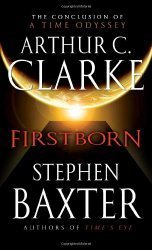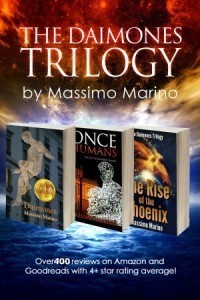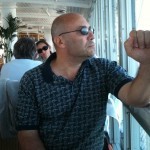Firstborn – Arthur C. Clark & Stephen Baxter

 An ancient race that will not share the available energy in the universe with other civilizations, and therefore is devoted to pursue the destruction of other intelligences as they become ‘competitors'; this is the premise of the great fresco by Arthur C. Clarke and Stephen Baxter dedicated to the fight of humanity against the Firstborn who first became known to science fiction fans as the builders of the iconic black monolith in 2001: A Space Odyssey. The Firstborn have inhabited legendary master of science fiction Sir Arthur C. Clarke’s writing for decades.
An ancient race that will not share the available energy in the universe with other civilizations, and therefore is devoted to pursue the destruction of other intelligences as they become ‘competitors'; this is the premise of the great fresco by Arthur C. Clarke and Stephen Baxter dedicated to the fight of humanity against the Firstborn who first became known to science fiction fans as the builders of the iconic black monolith in 2001: A Space Odyssey. The Firstborn have inhabited legendary master of science fiction Sir Arthur C. Clarke’s writing for decades.
The novel should conclude the “Time Odyssey” trilogy, picking up the threads left open in previous novels and revealing those mysteries remained unsolved.
The story opens with the awakening of Bisesa Dutt, brave British soldier and heroine of the two previous episodes, from a cryogenic sleep that lasted 19 years. Her daughter Myra awakes her, driven by an emergency situation: an alien probe had been detected in the deep space and is headed toward Earth, and now identified as a quantum bomb able to obliterate an entire planet.
Together with the young astronaut Alexei Carel, the two women fled from Earth through a space elevator, directed to Mars, where an Eye of the Firstborn had been found, preserved by the ancients and now disappeared Martians.
But this is only the first part of the long journey of Bisesa, who finds herself on Mir, the planet built by taking countless splinters time of Earth ages by the Firstborn, and where the young astronomer Abdikadir awaits.
In Babylon, the capital of the empire that Alexander the Great, (yes, THE Alexander the Great) intends to extend over the entire planet, a surprising news awaits Bisesa: in this pocket universe, Mars is blue and inhabited.
This and the discovery of the Eye allow to understand that in the past the mysterious Firstborn have already caused the extinction of an intelligent race in the solar system, the unfortunate Martians have not managed to avoid being swept away. Perhaps, now, the same fate awaits the human breed: it is the time of the end. More than science fiction, the story is full of Fantasy, with technology (and its descriptions) that clashes with science, so much so that I doubt Clarke, who lived through his last days, had the time to really work on this novel.
Spoiler alert: I’ll talk about details of the plot and the ending of the story, so if you are willing to read the novel, you should end now reading this review.
One would expect, from the third volume of a trilogy, some sort of conclusion, pleasant, surprising or predictable and disappointing as it will be, but a conclusion. It is not the case here.
What the novel does is to replicate situations seen in the first two volumes, the Earth is under attack and the situation of fantasy world of Mir, but does not give any answer to the open questions, on the contrary, it adds new ones and prepare the turf for a… quadrilogy?
The end of the novel sees the Q bomb destroy Mars, the Mars of our universe, sacrificed to save the Earth; Myra remains on the planet during the collapse, but somehow she does not die. She meets with Bisesa in an unknown place.
Daughter and mother were transported there by the Lastborn, beings of which we know nothing, just that they are at war with the Firstborn.
It goes without saying that the trilogy is transformed into a de facto quartet … at a minimum, but why limit yourself? Lastborn enter the stage as a Deus Ex Machina and voilà, nothing really ends and at least three other novels can now see the light.
But there is a much bigger problem that the prolongation, the stretching of the series: the gradual loss of interest for the story. The first novel was by a great idea, the second had been a passable catastrophic novel, while the latter — or rather penultimate chapter? — a total disappointment.
Paradoxically, it has been more credible the building of a miniuniverso containing a planet assembled with thousands of “splinters time” from Earth, the planet Mir seen in the first novel, than the actual solar system where the action takes place in Firstborn. Only a few decades have passed after a disaster that swept away a billion people and caused enormous destructions; one would expect to find humanity intent to lick their wounds, prepare a comeback, and not committed to blindly colonize the space, build huge telescopes in Antarctica, and spending time and resources to recreate extinct species.
Another questionable detail, because of the deployment of forces and the sentinels placed up to the orbit of Saturn, why the Firstborn are so kind to send their herald of death, the Q bomb, along the ecliptic rather than let it arrive unexpected following a different route? Burglars don’t announce themselves at the gate, walk straight to the main door of the mansion, and ring the bell.
The real critical point of the novel is not, however, its illogic fabric, rather the weary drag of the story, which has never tense moments and is lost in long descriptions of technological marvels and parts that taste like magic and stick to the walls with spit, just to fill a few pages, (example, see chapter 25.) With a full universe with alien species, the action is virtually absent, the protagonists spend most of their time traveling from place to place for inscrutable reasons. The Q bomb is a lingering plot gimmick, disturbing, and the murder attempt of Alexander the Great gives no emotion.
Some points of interest: the novel tries to please those interested in future technologies, and they will find many examples, from space elevators to solar sailing ships, all based on the latest available studies, but — again — they seem to be there just to add pages to a thin story.
It reads like badly written novel by a copycat writer of Arthur C. Clarke who only got the message “I need to write long technology descriptions, crazy, disruptive, wild, and I’m done.” I can only think that Clarke’s declining health has prevented him from giving his contribution (a few months after the publication the great writer left us), and that its decline coincided with that of this series.
To emphasize that the novel is a work of only Baxter I proceeded to clear the name of Clarke from the spine of the book. With a black marker.
Massimo Marino is a scientist envisioning science fiction. He spent years at CERN and The Lawrence Berkeley Lab followed by lead positions with Apple, Inc. and the World Economic Forum. He is also co-founder of “Squares on Blue”, a Big Data Analytics service company.
Massimo currently lives in France and crosses the border with Switzerland multiple times daily, although he is no smuggler.
As a scientist writing science fiction, he went from smashing particles at accelerators at SLAC and CERN to smashing words on a computer screen.
He’s the author of multi-awarded Daimones Trilogy.
His novels have received the Seal of Excellency from both AwesomeIndies.net and IndiePENdents.org
• 2012 PRG Reviewer’s Choice Award Winner in Science Fiction
• 2013 Hall of Fame – Best in Science Fiction, Quality Reads UK Book Club
• 2013 PRG Reviewer’s Choice Award Winner in Science Fiction Series
• 2014 Finalist – Science Fiction – Indie Excellence Awards L.A.
• 2014 Award Winner – Science Fiction Honorable Mention – Readers’ Favorite Annual Awards
His novels are available from Amazon, Barnes & Noble (Nook), iTunes Apple Store, and many other retailers around the world.
Join his mailing list for new releases, or follow him on Facebook, Google+, and Twitter.
The post Firstborn – Arthur C. Clark & Stephen Baxter appeared first on § Author Massimo Marino.




